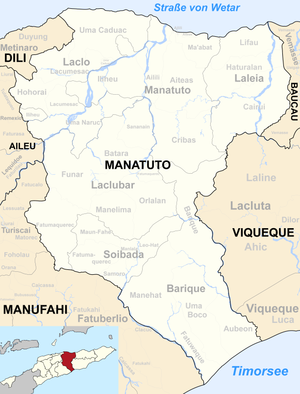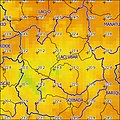Laclubar (administrative office)
| Laclubar administrative office | ||
|
|
||
| Administrative headquarters | Laclubar | |
| surface | 399.79 km² | |
| population | 12,050 (2015) | |
| Sucos | Population (2015) | |
| Batara | 2,367 | |
| Fatumaquerec | 863 | |
| Funar | 1.166 | |
| Manelima | 2,195 | |
| Orlalan | 4,841 | |
| Sananain | 618 | |
| Overview map | ||

|
||
Laclubar is an East Timorese administrative office ( Portuguese Posto Administrativo ) in the municipality of Manatuto . The seat of the administration is in Suco Orlalan in the place Laclubar .
geography
Until 2014, the administrative offices were still referred to as sub-districts . Before the 2015 regional reform, Laclubar had an area of 392.00 km². Now there are 399.79 km².
The Laclubar Administrative Office is located in the center of East Timor and in the west of the municipality of Manatuto. It is divided into six sucos : Batara , Fatumaquerec (Fatumakerek), Funar , Manelima , Orlalan and Sananain (Sanana'in).
According to modern sources, there are no longer any active volcanoes on Timor . However, Arthur Wichmann reports a volcano near Laclubar at the end of the 19th century, but no eruptions are reported. It had five larger craters with a diameter of around 16 meters and a few smaller ones from which “ bituminous ” matter oozed.
- Climate data
Residents
12,050 people live in the Laclubar administrative office (2015), of which 6,031 are men and 6,019 women. The population density is 30.1 inhabitants / km². The largest language group are the speakers of the Idaté dialect around Laclubar. Another large group are the speakers of the Lakalei dialect in the western part of Fahinehan . Both dialects belong to the Idalaka language group , which is recognized as the national language in East Timor. The average age of the population is 17.8 years (2010, 2004: 18.5 years).
history

Laclubar was one of the traditional empires of Timor, ruled by a liurai . According to local lore, it was subordinate to the Samoro Empire for a long time . According to legend, the later Liurai Dom Geraldo managed to use the magical powers of the land to lead Laclubar to independence from the neighboring kingdom. Laclubar is therefore still called "Little Samoro" ( tetum Samoro kiik ) by some people .
In historical records, Laclubar first appears on the list of Afonso de Castro , a former governor of Portuguese Timor who listed 47 empires in 1868. Governor José Celestino da Silva names Laclubar 1896 as one of the empires that is not subordinate to another. In 1898 a Portuguese military post was established in Laclubar. In 1905 Funar was attacked by the Portuguese. The small kingdom owned a large herd of buffalo. When it refused to sell it, the scorned buyer Manuel das Neves complained to Governor José Celestino da Silva, who sent a punitive expedition against the alleged rebels. 800 Timorese warriors in Portuguese service fought for 26 days, Funar was sacked and devastated. The survivors were taken to Manatuto. Funar's territory was divided among the neighboring empires.
Because of its surface oil and natural gas deposits, the region was also called the “Land of Eternal Fire”. Since 1884 the lamps of the colonial capital Dilis have been supplied with oil from Laclubar. German, British and Australian companies began researching in the region around Pualaca in the 1890s . A British company even had a permanent presence in the region from 1910 onwards.
Even in the run-up to the Indonesian invasion of 1975, Laclubar's population was politically divided. There were supporters of all three major parties: FRETILIN , UDT and APODETI . After the Indonesian invasion, Laclubar became a retreat for the FALINTIL , the FRETILIN guerrillas who fought against the Indonesian invaders. A base de apoio was created , a resistance base that offered refuge for refugees from Laclubar, Soibada and Manatuto. But it was later destroyed by the Indonesians. In the places Laclubar, Le'i and Lafulau there were Indonesian assembly camps for East Timorese at the end of 1979, who should be relocated by the occupiers for better control.
In 1999, in the context of the independence referendum, there were also attacks in Laclubar by Indonesians and East Timorese sympathizers. Several supporters of independence were murdered in Laclubar and the place was partially burned down. The same fate overtook Manelima by Indonesian security forces on the night of April 24, 1999. Most of those resettled during the occupation returned to their home regions after the independence of East Timor in 2002. A part of the former population of Laclubar now lives in the Indonesian West Timor . Laclubar was often suspected of collaborating with the Indonesian occupiers, as José Abílio Osório Soares , the last Indonesian governor of Timor Timur, came from here.
During the riots in 2006 between western East Timorese and eastern East Timorese , the many residents of Laclubar saw themselves as neutral residents of the “land in the middle” ( tetum rai clear ).
politics
The administrator of the administrative office is appointed by the central government in Dili. In 2009 Agripino SSR Costa was appointed administrator. In 2015 the office was held by Rui Soares .
economy
71% of the households in Laclubar grow cassava , 73% corn, 63% coffee, 60% vegetables, 23% coconuts and 8% rice. The region is also known for its palm wine , which is sold at the Sunday market in Laclubar. In the southwest there are small deposits of chromium , in the south near Pualaca crude oil and natural gas.
Most towns are inaccessible by car and heavy rains can cut them off from the outside world for good.
Web links
- Judith Bovensiepen: Opening and Closing the Land: Land and power in the Idaté highlands
Individual evidence
- ↑ a b c d e Direcção-Geral de Estatística : Results of the 2015 census , accessed on November 23, 2016.
- ↑ Jornal da República : Diploma Ministerial no 24/2014 de 24 de Julho - Orgânica dos Postos Administrativos ( Memento of March 4, 2016 in the Internet Archive )
- ↑ a b Direcção Nacional de Estatística: 2010 Census Wall Chart (English) ( Memento of the original from August 12, 2011 in the Internet Archive ) Info: The archive link was automatically inserted and not yet checked. Please check the original and archive link according to the instructions and then remove this notice. (PDF; 2.5 MB)
- ^ Arthur Wichmann: Rocks from Timor and some adjacent islands , collections of the Geological Museum in Leiden (Google Books). Leiden, EJ Brill, 1882-1887, volumes 10-11, p. 165.
- ↑ a b Seeds of Life
- ↑ Direcção Nacional de Estatística: Census of Population and Housing Atlas 2004 ( Memento of November 13, 2012 in the Internet Archive ) (PDF; 14.0 MB; English)
- ↑ a b c d e f g h i j Judith Bovensiepen: Opening and Closing the Land: Land and power in the Idaté highlands , accessed on March 29, 2015.
- ↑ Timor Loro Sae: Um pouco de história ( Memento of the original of November 13, 2001 in the Internet Archive ) Info: The archive link was inserted automatically and has not yet been checked. Please check the original and archive link according to the instructions and then remove this notice.
- ^ East Timor - Portuguese Dependency of East Timor ( Memento of February 21, 2004 in the Internet Archive )
- ↑ Monika Schlicher: Portugal in East Timor. A critical examination of the Portuguese colonial history in East Timor from 1850 to 1912. Aberag, Hamburg 1996. ISBN 3-934376-08-8 .
- ^ Geoffrey C. Gunn: History of Timor. ( Memento of the original from March 24, 2009 in the Internet Archive ) Info: The archive link was inserted automatically and has not yet been checked. Please check the original and archive link according to the instructions and then remove this notice. Technical University of Lisbon (PDF file; 805 kB)
- ↑ a b Chapter 7.3 Forced Displacement and Famine ( Memento of the original from November 28, 2015 in the Internet Archive ) Info: The archive link was automatically inserted and not yet checked. Please check the original and archive link according to the instructions and then remove this notice. (PDF; 1.3 MB) from the “Chega!” Report by CAVR (English).
- ↑ Geoffrey Robinson: "Annexe 1: East Timor 1999 Crimes against Humanity" ( Memento of the original from September 5, 2014 in the Internet Archive ) Info: The archive link was inserted automatically and has not yet been checked. Please check the original and archive link according to the instructions and then remove this notice. from the "Chega!" report by CAVR (English)
- ↑ Jornal da República: DESPACHO No.37 / MAEOT / 2009 , accessed on January 20, 2018.
- ↑ Ministério da Administração Estatal: Administração Municipal ( Memento of the original from June 1, 2016 in the Internet Archive ) Info: The archive link has been inserted automatically and has not yet been checked. Please check the original and archive link according to the instructions and then remove this notice.
- ↑ Direcção Nacional de Estatística: Suco Report Volume 4 ( Memento of the original of April 9, 2015 in the Internet Archive ) Info: The archive link has been inserted automatically and has not yet been checked. Please check the original and archive link according to the instructions and then remove this notice. (PDF; 9.8 MB; English)
Coordinates: 8 ° 45 ' S , 125 ° 55' E




